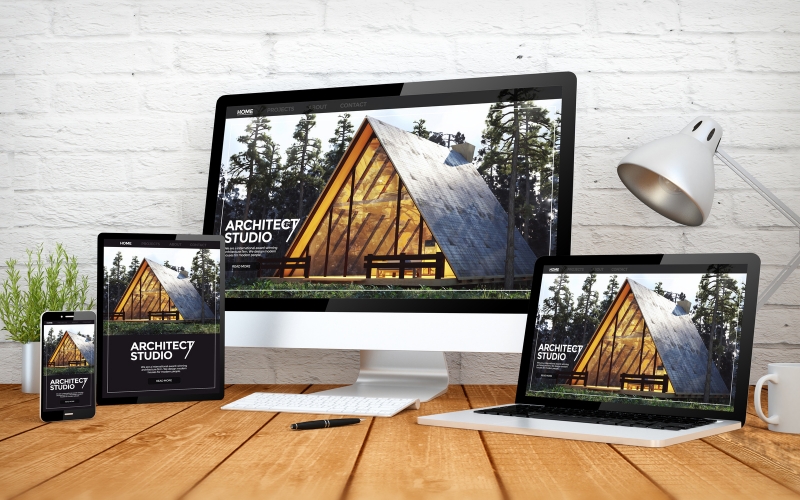
Website aesthetics play a pivotal role in shaping how users perceive a brand’s trustworthiness and professionalism. From the moment a visitor lands on a site, design elements such as color, typography, and layout work together to create an impression that can either foster confidence or raise doubts. The impact of website aesthetics goes beyond just visual appeal; it influences user engagement, navigation, and the overall credibility of the site. In this article, we’ll explore the various aspects of website aesthetics and how they contribute to building trust and credibility with your audience.
The Role of Visual Design in User Perception

Website aesthetics play a critical role in shaping how users perceive a website’s trustworthiness. From the moment a visitor lands on a website, the design elements such as color, typography, and layout work together to form an immediate impression. These visual elements not only influence user engagement but also determine whether users feel comfortable enough to trust the site with their time, information, or even purchases.
Colors are among the first design elements that users notice when visiting a website. Different colors evoke different emotions and perceptions. For example, blue is often associated with trust, security, and professionalism, which is why it’s commonly used by financial institutions or healthcare websites. On the other hand, vibrant colors like orange or yellow can signal energy and enthusiasm, making them ideal for entertainment or lifestyle brands. The strategic use of colors in website aesthetics can instantly set the tone for a user’s experience and help create a sense of reliability or urgency, depending on the goal of the site.
Typography also plays an essential role in how users perceive a website’s credibility. The choice of font and its readability directly affect the user’s ability to digest content and feel confident in the site’s professionalism. Elegant serif fonts are often used for more traditional or high-end sites, while modern sans-serif fonts are more commonly found on tech-savvy or innovative websites. A website’s typography should reflect its purpose, and inconsistent or hard-to-read fonts can leave visitors questioning the site’s authenticity or authority.
Furthermore, the layout and structure of a website significantly influence its perceived trustworthiness. A clean, organized layout ensures that users can easily navigate through content without feeling overwhelmed. A cluttered or disorganized layout, on the other hand, can lead to frustration and cause users to question the site’s credibility. The way content is arranged – from clear navigation menus to consistent headers and well-spaced sections – enhances the user experience and reinforces the idea that the website is professional and trustworthy.
The Connection Between Professional Design and Credibility

In the digital age, a website’s aesthetics are more than just eye-catching visuals – they are often the first indicators of a company’s credibility and professionalism. The connection between professional design and credibility is undeniable, as a polished, well-thought-out website aesthetic signals reliability, competence, and trustworthiness. Conversely, poor design choices can raise doubts, leading visitors to question the legitimacy of a business or brand.
Website aesthetics play a crucial role in the way users perceive a company’s credibility. A clean, polished design communicates that the company values quality and professionalism, which instills confidence in the visitor. The first impression matters, and users are more likely to trust a website that looks modern, user-friendly, and visually appealing. A professional design often reflects a business’s commitment to providing a high-quality experience, whether in terms of customer service, products, or services. A website that is visually appealing and well-organized demonstrates attention to detail, which fosters a sense of trust in potential customers.
On the other hand, a website with unprofessional or outdated design can raise red flags for visitors. For instance, broken links, poor color choices, and unreadable fonts can make a website look unreliable and outdated. If users encounter a website that appears neglected or hard to navigate, they are more likely to leave, as they may question whether the business behind the site is trustworthy. In the digital world, a poorly designed website can directly affect a company’s reputation and diminish the sense of credibility that they’ve worked hard to establish.
Consistency in website aesthetics is also key to maintaining credibility. A cohesive design, where elements such as logos, fonts, and color schemes align, ensures that the website reflects a unified brand image. When a website’s design elements are inconsistent or disjointed, users may feel disoriented, which can lead to a lack of confidence in the website’s legitimacy. In contrast, a consistent and harmonious design enhances a sense of professionalism and assures visitors that the website is run by a reliable, well-established entity.
Consistency and Cohesion: Building a Unified Brand Image

Website aesthetics are a crucial part of how users perceive a brand’s identity, and consistency in design elements plays a significant role in enhancing credibility and creating a unified image. A well-executed, cohesive design ensures that all elements on a website – from logos and fonts to color schemes – work together harmoniously to represent the brand’s values and message. When users encounter a visually consistent website, they are more likely to trust the business and feel that the brand is professional and reliable.
One of the first steps in building a strong, unified brand image is ensuring that all design elements align with the brand’s identity. The logo, fonts, and color schemes should reflect the business’s core values and target audience. For example, a tech startup may use modern, sans-serif fonts and bold colors to convey innovation and forward-thinking, while a luxury brand may opt for elegant serif fonts and muted tones to convey sophistication and exclusivity. When these elements are consistent across the website, they help create a clear, identifiable brand that users can easily recognize and connect with.
The impact of consistent website aesthetics goes beyond just visual appeal – it also influences user experience and trust. A website that consistently uses the same colors, fonts, and layout structures across all pages creates a sense of cohesion and reliability. Visitors don’t have to worry about navigating a confusing, jarring design that might leave them feeling uncertain about the brand. Instead, they are met with a professional, organized website that feels stable and trustworthy. Consistency in design assures users that the business behind the site is established, dependable, and committed to providing a seamless experience.
Moreover, website aesthetics that emphasize consistency help strengthen brand recognition. When design elements are repeated throughout the website, users become familiar with the visual cues associated with the brand. This familiarity breeds trust and loyalty, making users more likely to return to the site or engage with the business in other ways, such as making a purchase or signing up for a service.
Mobile Responsiveness and User Experience: Trust through Functionality

In today’s digital landscape, mobile responsiveness is a critical aspect of website aesthetics, playing a significant role in both user experience and trust-building. With a growing number of internet users accessing websites through mobile devices, it has become essential for businesses to ensure that their websites function seamlessly across all platforms. A website that adapts smoothly to different screen sizes and devices doesn’t just enhance user experience; it also instills trust in the brand’s reliability and professionalism.
When a website is mobile-responsive, it automatically adjusts its layout and content to fit the screen of any device, whether it’s a smartphone, tablet, or desktop. This flexibility ensures that users can access the site with ease, no matter how they are browsing. A website that is optimized for mobile devices ensures that users don’t have to zoom in or scroll excessively to view content, which enhances readability and navigation. The ease of use provided by a responsive design leads to a more positive user experience, encouraging visitors to stay longer and explore the site further.
From a trust perspective, a mobile-responsive website reflects the business’s attention to detail and commitment to providing a high-quality experience for all users. Websites that are not mobile-friendly often lead to frustration, as users may encounter issues with formatting, broken images, or slow load times. Such negative experiences can create doubts about the legitimacy and reliability of the business behind the website. On the other hand, when users find a website that functions smoothly across devices, it builds a sense of confidence in the brand. The functionality and ease of navigation contribute to the overall credibility of the site, reinforcing the message that the business is professional, competent, and reliable.
Incorporating mobile responsiveness into website aesthetics is no longer just a nice-to-have feature; it is a necessity for ensuring that the site caters to a broad audience. Moreover, search engines like Google now prioritize mobile-friendly websites in their rankings, which means that mobile optimization not only improves user experience but also boosts the site’s visibility and performance.
The Impact of Visual Clutter and Simplicity on User Confidence

Website aesthetics play a vital role in user experience, and one of the most influential aspects of design is the presence or absence of visual clutter. A clean, minimalist website design can significantly reduce confusion, creating a calm and organized environment that enhances user confidence and trust. In contrast, websites overloaded with unnecessary images, text, or elements can lead to a chaotic user experience, leaving visitors feeling frustrated and unsure about the credibility of the site.
The essence of minimalist design lies in the concept of simplicity. By focusing on essential elements and eliminating distractions, a website can communicate its message clearly and effectively. When users land on a site with a clean design, they can quickly navigate through the content without feeling overwhelmed. Important information is highlighted, call-to-action buttons are easy to find, and the layout guides the user seamlessly from one section to another. This simplicity fosters a sense of control, as users feel confident in their ability to understand and interact with the website.
On the other hand, visual clutter—such as excessive text, overlapping images, or too many colors—can have a detrimental effect on user confidence. A website that is overly crowded can create confusion and anxiety, making users question the professionalism of the site. If important content is hidden behind too many competing elements, visitors may struggle to find what they need, leading to frustration and, ultimately, a lack of trust. A cluttered website often appears unorganized and unprofessional, signaling to users that the business may not be reliable or credible.
In terms of website aesthetics, simplicity directly correlates with trust. A streamlined, easy-to-navigate website sends a message that the business is thoughtful, deliberate, and user-centric. This perception of professionalism and attention to detail makes users more likely to engage with the site, share personal information, or make a purchase. Clean design elements, such as plenty of white space, readable fonts, and well-organized content, enhance the overall user experience, making visitors feel comfortable and secure.
Conclusion
Understanding how website aesthetics influence user trust is crucial for businesses looking to enhance their online presence. A well-designed website not only improves user experience but also plays a vital role in establishing credibility. For more insights into the role of design in website performance and trust-building, check out this article from Smashing Magazine, which delves deeper into the relationship between web design and user confidence.
In conclusion, website aesthetics are far more than just a design choice – they are essential to establishing trust and credibility with your audience. Whether it’s the color scheme, typography, or layout, every design element plays a significant role in how users perceive your site. A clean, consistent, and mobile-responsive design enhances user experience, while simplicity can reduce visual clutter and boost confidence in your brand. By prioritizing effective website aesthetics, businesses can not only improve user engagement but also foster lasting trust and credibility, ultimately contributing to their success in the digital landscape.
For more details or to discuss your specific Website Development and Design, visit our Website Development and Design page.

